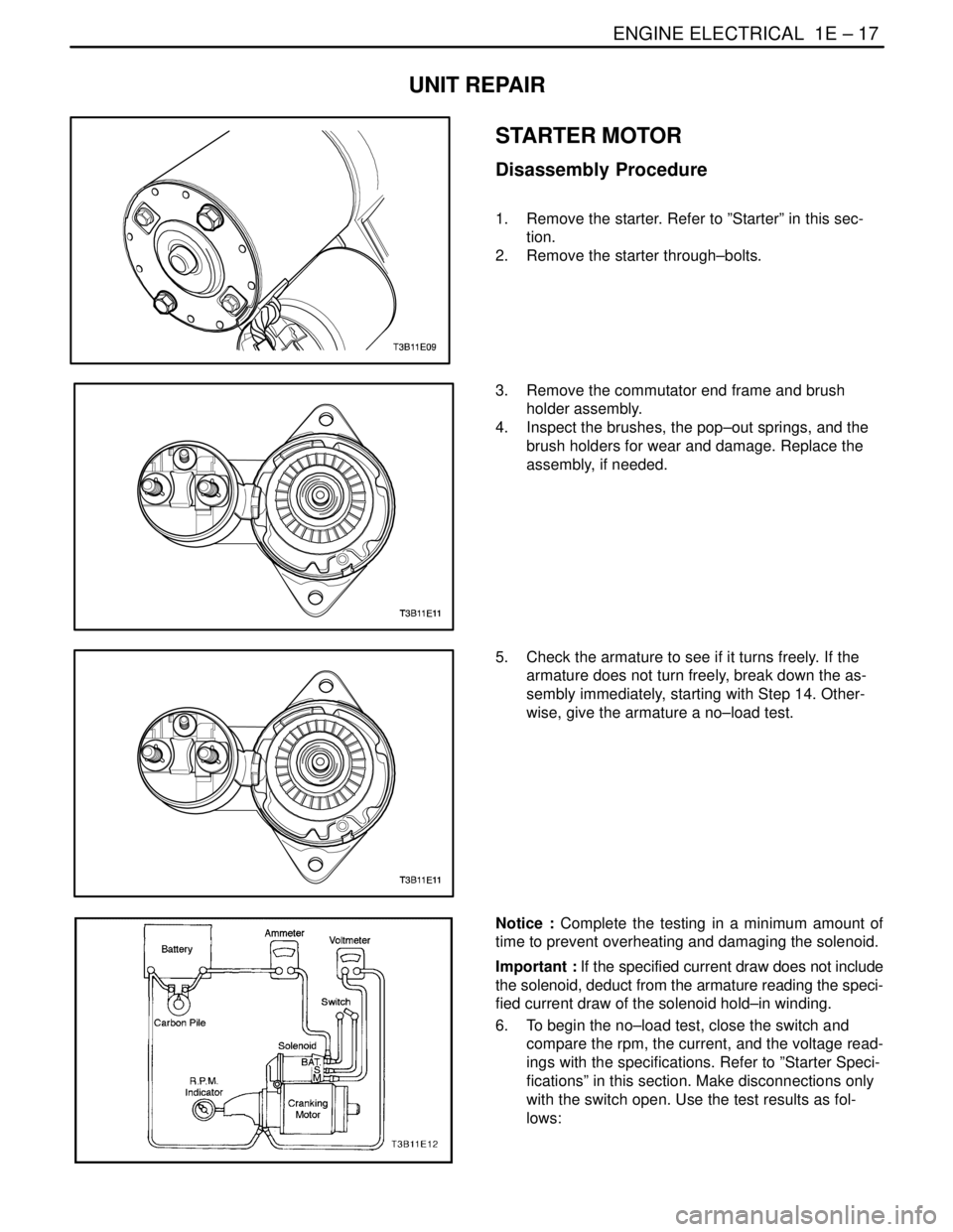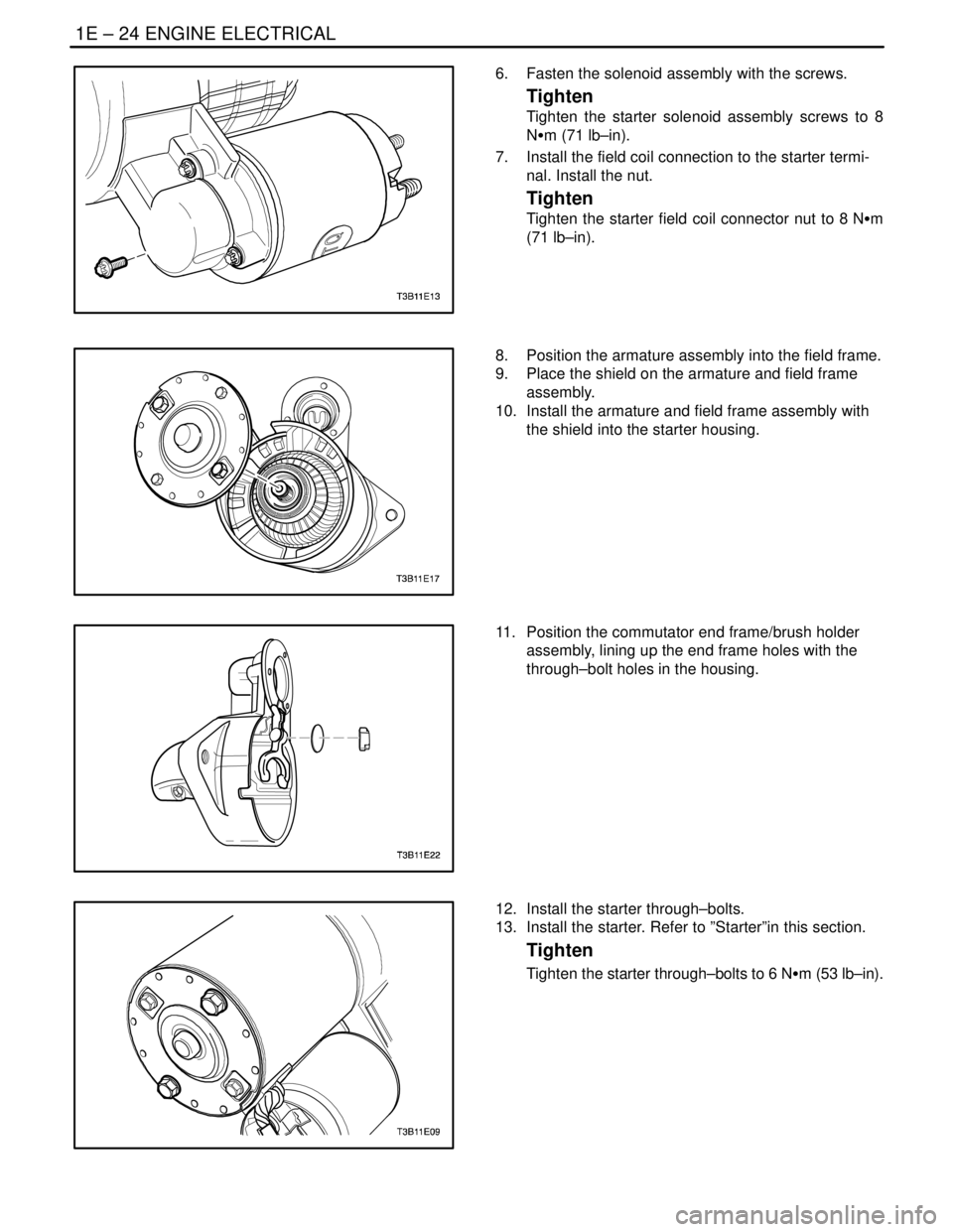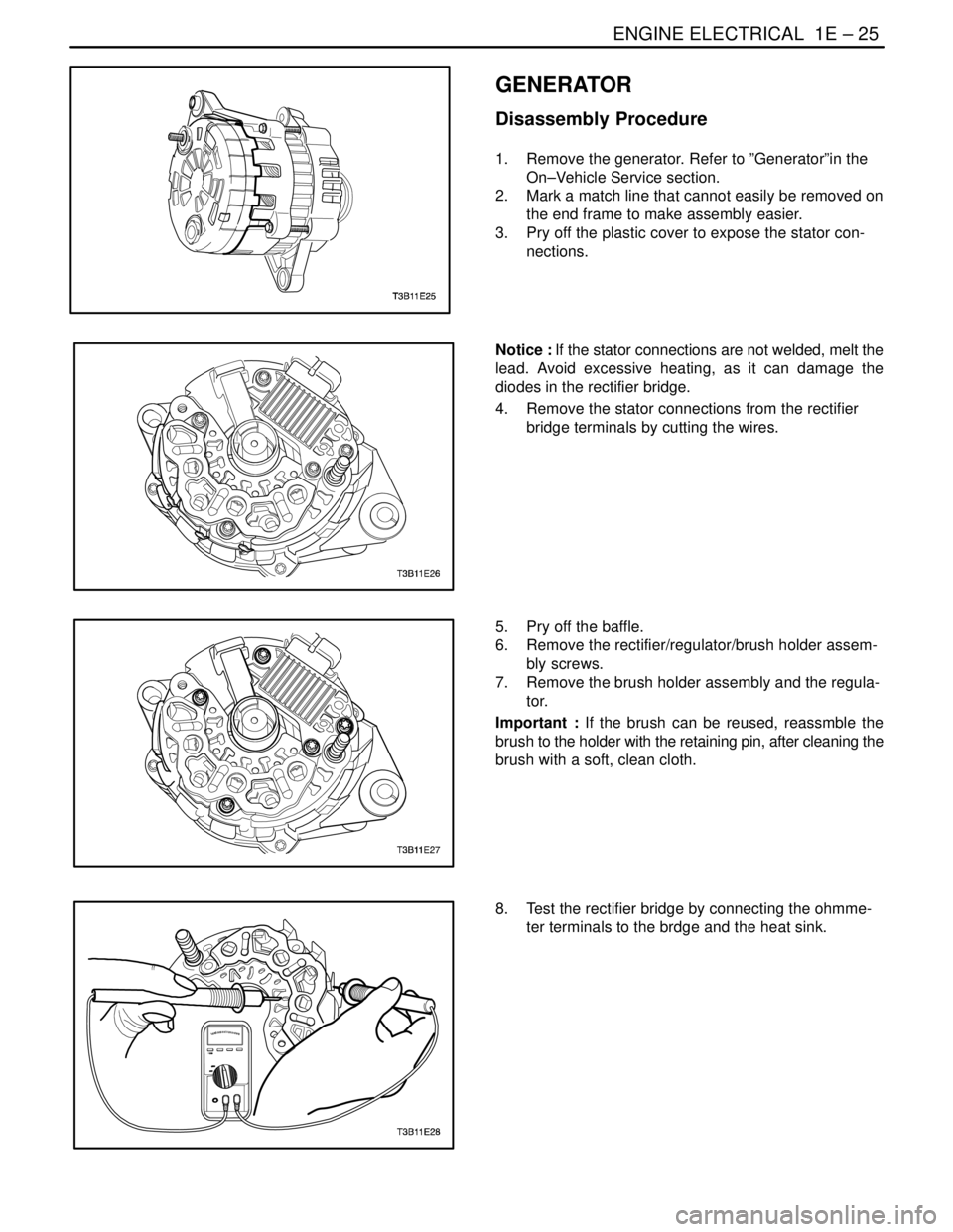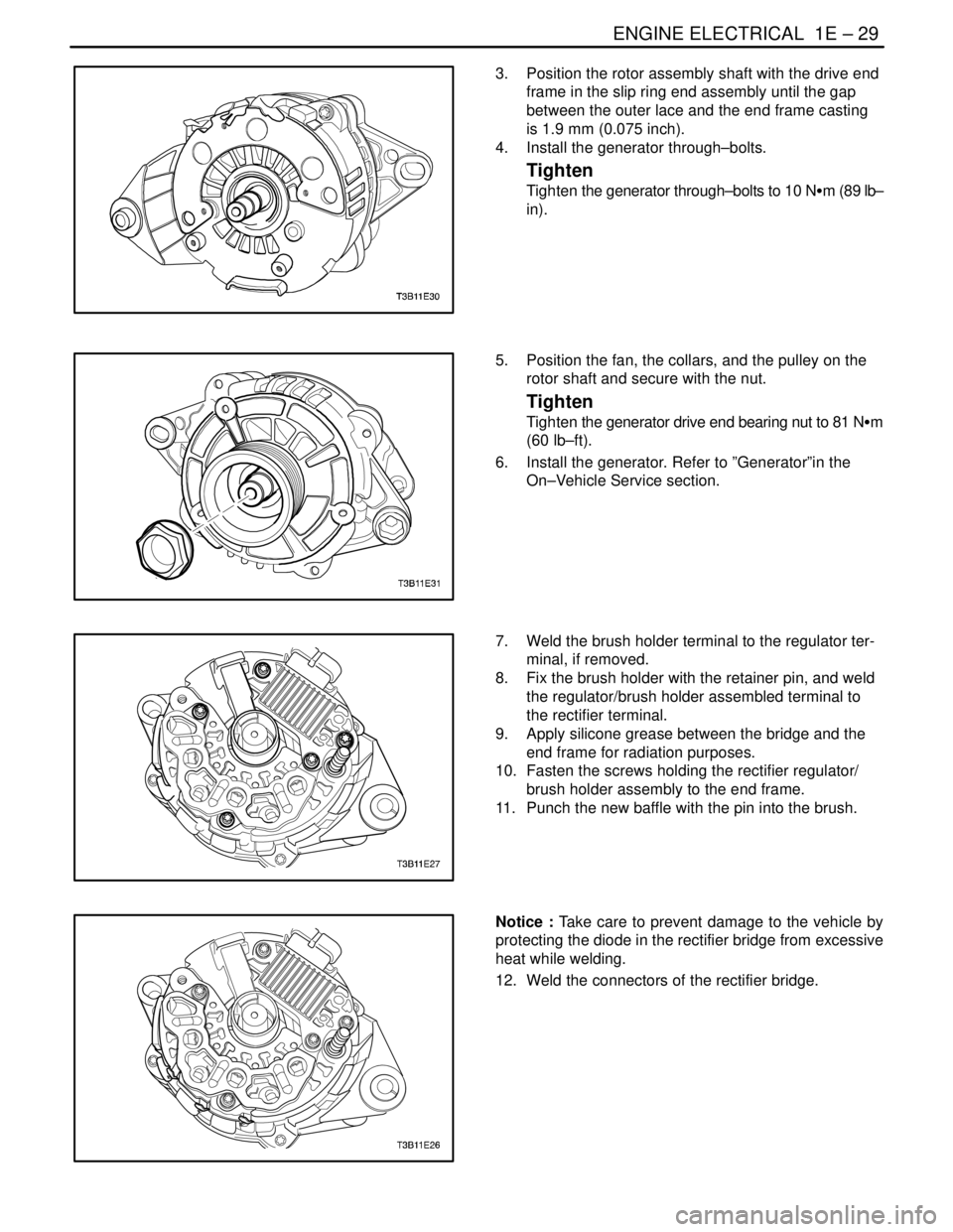2004 DAEWOO LACETTI Section 6
[x] Cancel search: Section 6Page 231 of 2643

ENGINE ELECTRICAL 1E – 17
DAEWOO V–121 BL4
UNIT REPAIR
STARTER MOTOR
Disassembly Procedure
1. Remove the starter. Refer to ”Starter” in this sec-
tion.
2. Remove the starter through–bolts.
3. Remove the commutator end frame and brush
holder assembly.
4. Inspect the brushes, the pop–out springs, and the
brush holders for wear and damage. Replace the
assembly, if needed.
5. Check the armature to see if it turns freely. If the
armature does not turn freely, break down the as-
sembly immediately, starting with Step 14. Other-
wise, give the armature a no–load test.
Notice : Complete the testing in a minimum amount of
time to prevent overheating and damaging the solenoid.
Important : If the specified current draw does not include
the solenoid, deduct from the armature reading the speci-
fied current draw of the solenoid hold–in winding.
6. To begin the no–load test, close the switch and
compare the rpm, the current, and the voltage read-
ings with the specifications. Refer to ”Starter Speci-
fications” in this section. Make disconnections only
with the switch open. Use the test results as fol-
lows:
Page 238 of 2643

1E – 24IENGINE ELECTRICAL
DAEWOO V–121 BL4
6. Fasten the solenoid assembly with the screws.
Tighten
Tighten the starter solenoid assembly screws to 8
NSm (71 lb–in).
7. Install the field coil connection to the starter termi-
nal. Install the nut.
Tighten
Tighten the starter field coil connector nut to 8 NSm
(71 lb–in).
8. Position the armature assembly into the field frame.
9. Place the shield on the armature and field frame
assembly.
10. Install the armature and field frame assembly with
the shield into the starter housing.
11. Position the commutator end frame/brush holder
assembly, lining up the end frame holes with the
through–bolt holes in the housing.
12. Install the starter through–bolts.
13. Install the starter. Refer to ”Starter”in this section.
Tighten
Tighten the starter through–bolts to 6 NSm (53 lb–in).
Page 239 of 2643

ENGINE ELECTRICAL 1E – 25
DAEWOO V–121 BL4
GENERATOR
Disassembly Procedure
1. Remove the generator. Refer to ”Generator”in the
On–Vehicle Service section.
2. Mark a match line that cannot easily be removed on
the end frame to make assembly easier.
3. Pry off the plastic cover to expose the stator con-
nections.
Notice : If the stator connections are not welded, melt the
lead. Avoid excessive heating, as it can damage the
diodes in the rectifier bridge.
4. Remove the stator connections from the rectifier
bridge terminals by cutting the wires.
5. Pry off the baffle.
6. Remove the rectifier/regulator/brush holder assem-
bly screws.
7. Remove the brush holder assembly and the regula-
tor.
Important : If the brush can be reused, reassmble the
brush to the holder with the retaining pin, after cleaning the
brush with a soft, clean cloth.
8. Test the rectifier bridge by connecting the ohmme-
ter terminals to the brdge and the heat sink.
Page 243 of 2643

ENGINE ELECTRICAL 1E – 29
DAEWOO V–121 BL4
3. Position the rotor assembly shaft with the drive end
frame in the slip ring end assembly until the gap
between the outer lace and the end frame casting
is 1.9 mm (0.075 inch).
4. Install the generator through–bolts.
Tighten
Tighten the generator through–bolts to 10 NSm (89 lb–
in).
5. Position the fan, the collars, and the pulley on the
rotor shaft and secure with the nut.
Tighten
Tighten the generator drive end bearing nut to 81 NSm
(60 lb–ft).
6. Install the generator. Refer to ”Generator”in the
On–Vehicle Service section.
7. Weld the brush holder terminal to the regulator ter-
minal, if removed.
8. Fix the brush holder with the retainer pin, and weld
the regulator/brush holder assembled terminal to
the rectifier terminal.
9. Apply silicone grease between the bridge and the
end frame for radiation purposes.
10. Fasten the screws holding the rectifier regulator/
brush holder assembly to the end frame.
11. Punch the new baffle with the pin into the brush.
Notice : Take care to prevent damage to the vehicle by
protecting the diode in the rectifier bridge from excessive
heat while welding.
12. Weld the connectors of the rectifier bridge.
Page 245 of 2643

ENGINE ELECTRICAL 1E – 31
DAEWOO V–121 BL4
trolyte and the plates are at room temperature. A
battery that is extremely cold may not accept cur-
rent for several hours after starting the charger.
3. Charge the battery until the green dot appears. The
battery should be checked every half–hour while
charging. Tipping or shaking the battery may be
necessary to make the green dot appear.
4. After charging, the battery should be load tested.
Refer to ”Starter Motor” in this section.
CHARGING TIME REQUIRED
The time required to charge a battery will vary depending
upon the following factors:
S Size of Battery – A completely discharged large
heavy–duty battery requires more than twice the re-
charging time as a completely discharged small pas-
senger car battery.
S Temperature – A longer time will be needed to
charge any battery at –18°C (0°F) than at 27°C
(80°F). When a fast charger is connected to a cold
battery, the current accepted by the battery will be
very low at first. The battery will accept a higher cur-
rent rate as the battery warms.
S Charger Capacity – A charger which can supply only
5 amperes will require a much longer charging period
than a charger that can supply 30 amperes or more.
S State–of–Charge – A completely discharged battery
requires more than twice as much charge as a one–
half charged battery. Because the electrolyte is nearly
pure water and a poor conductor in a completely dis-
charged battery, the current accepted by the battery
is very low at first. Later, as the charging current
causes the electrolyte acid content to increase, the
charging current will likewise increase.
CHARGING A COMPLETELY
DISCHARGED BATTERY (OFF THE
VEHICLE)
Unless this procedure is properly followed, a perfectly
good battery may need to be replaced.
The following procedure should be used to recharge a
completely discharged battery:
1. Measure the voltage at the battery terminals with
an accurate voltmeter. If the reading is below 10
volts, the charge current will be very low, and it
could take some time before the battery accepts
the current in excess of a few milliamperes. Refer
to ””Charging Time Required” in this section, which
focuses on the factors affecting both the charging
time required and the rough estimates in the table
below. Such low current may not be detectable on
ammeters available in the field.
2. Set the battery charger on the high setting.Important : Some chargers feature polarity protection cir-
cuitry, which prevents charging unless the charger leads
are correctly connected to the battery terminals. A com-
pletely discharged battery may not have enough voltage
to activate this circuitry, even though the leads are con-
nected properly, making it appear that the battery will not
accept charging current. Therefore, follow the specific
charger manufacturer’s instruction for bypassing or over-
riding the circuitry so that the charger will turn on and
charge a low–voltage battery.
3. Continue to charge the battery until the charge cur-
rent is measurable. Battery chargers vary in the
amount of voltage and current provided. The time
required for the battery to accept a measurable
charge current at various voltages may be as fol-
lows:
Voltage
Hours
16.0 or moreUp to 4 hours
14.0–15.9Up to 8 hours
13.9 or lessUp to 16 hours
S If the charge current is not measurable at the
end of the above charging times, the battery
should be replaced.
S If the charge current is measurable during the
charging time, the battery is good, and charging
should be completed in the normal manner.
Important : It is important to remember that a completely
discharged battery must be recharged for a sufficient num-
ber of ampere hours (AH) to restore the battery to a usable
state. As a general rule, using the reserve capacity rating
(RC) as the number of ampere hours of charge usually
brings the green dot into view.
S If the charge current is still not measurable after
using the charging time calculated by the above
method, the battery should be replaced.
JUMP STARTING PROCEDURE
1. Position the vehicle with the good (charged) battery
so that the jumper cables will reach.
2. Turn off the ignition, all the lights, and all the electri-
cal loads in both vehicles. Leave the hazard flasher
on if jump starting where there may be other traffic
and any other lights needed for the work area.
3. In both vehicles, apply the parking brake firmly.
Notice : To avoid vehicle damage,Make sure the cables
are not on or near pulleys, fans, or other parts that will
move when the engine starts.
4. Shift an automatic transaxle to PARK, or a manual
transaxle to NEUTRAL.
CAUTION : In order to avoid injury, do not use cables
that have loose or missing insulation.
5. Clamp one end of the first jumper cable to the posi-
tive terminal on the battery. Make sure it does not
touch any other metal parts. Clamp the other end of
Page 246 of 2643

1E – 32IENGINE ELECTRICAL
DAEWOO V–121 BL4
the same cable to the positive terminal on the other
battery. Never connect the other end to the nega-
tive terminal of the discharged battery.
CAUTION : To avoid injury do not attach the cable di-
rectly to the negative terminal of the discharged bat-
tery. Doing so could cause sparks and a possible bat-
tery explosion.
6. Clamp one end of the second cable to the negative
terminal of the booster battery. Make the final con-
nection to a solid engine ground (such as the en-
gine lift bracket) at least 450 millimeters (18 inches)
from the discharged battery.
7. Start the engine of the vehicle with the good bat-
tery. Run the engine at a moderate speed for sever-
al minutes. Then start the engine of the vehicle
which has the discharged battery.
8. Remove the jumper cables by reversing the above
sequence exactly. Remove the negative cable from
the vehicle with the discharged battery first. While
removing each clamp, take care that it does not
touch any other metal while the other end remains
attached.
GENERATOR
The Delco–Remy CS charging system has several mod-
els available, including the CS. The number denotes the
outer diameter in millimeters of the stator lamination.
CS generators are equipped with internal regulators. A
Delta stator, a rectifier bridge, and a rotor with slip rings
and brushes are electrically similar to earlier generators.
A conventional pulley and fan are used. There is no test
hole.
Unlike three–wire generators, the CS may be used with
only two connections: battery positive and an ”L’’ terminal
to the charge indicator lamp.
As with other charging systems, the charge indicator lamp
lights when the ignition switch is turned to RUN, and goes
out when the engine is running. If the charge indicator is
on with the engine running, a charging system defect is in-
dicated. This indicator light will glow at full brilliance for
several kinds of defects as well as when the system volt-
age is too high or too low.The regulator voltage setting varies with temperature and
limits the system voltage by controlling rotor field current.
At high speeds, the on–time may be 10 percent and the
off–time 90 percent. At low speeds, with high electrical
loads, on–time may be 90 percent and the off–time 10 per-
cent.
CHARGING SYSTEM
CS generators use a new type of regulator that incorpo-
rates a diode trio. A Delta stator, a rectifier bridge, and a
rotor with slip rings and brushes are electrically similar to
earlier generators. A conventional pulley and fan are used.
There is no test hole.
STARTER
Wound field starter motors have pole pieces, arranged
around the armature, which are energized by wound field
coils.
Enclosed shift lever cranking motors have the shift lever
mechanism and the solenoid plunger enclosed in the drive
housing, protecting them from exposure to dirt, icy condi-
tions, and splashes.
In the basic circuit, solenoid windings are energized when
the switch is closed. The resulting plunger and shift lever
movement causes the pinion to engage the engine fly-
wheel ring gear. The solenoid main contacts close. Crank-
ing then takes place.
When the engine starts, pinion overrun protects the arma-
ture from excessive speed until the switch is opened, at
which time the return spring causes the pinion to disen-
gage. To prevent excessive overrun, the switch should be
released immediately after the engine starts.
STARTING SYSTEM
The engine electrical system includes the battery, the igni-
tion, the starter, the generator, and all the related wiring.
Diagnostic tables will aid in troubleshooting system faults.
When a fault is traced to a particular component, refer to
that component section of the service manual.
The starting system circuit consists of the battery, the
starter motor, the ignition switch, and all the related electri-
cal wiring. All of these components are connected electri-
cally.
Page 247 of 2643

SECTION : 1F
ENGINE CONTROLS
CAUTION : Disconnect the negative battery cable before removing or installing any electrical unit o r w hen a
tool or equipment could easily come in contact with exposed electrical terminals. Disconnecting this cable will
help prevent personal injury and damage to the vehicle. The ignition must also be in LOCK unless otherwise
noted.
TABLE OF CONTENTS
SPECIFICATIONS1F–6 . . . . . . . . . . . . . . . . . . . . . . . . . .
Engine Data Display Tables 1F–6. . . . . . . . . . . . . . . . .
Engine Data Display Table Definitions 1F–7. . . . . . . .
Fastener Tightening Specifications 1F–10. . . . . . . . .
Fuel System Specifications 1F–11. . . . . . . . . . . . . . . . .
Temperature Vs Resistance 1F–11. . . . . . . . . . . . . . . .
SCHEMATIC AND ROUTING DIAGRAMS1F–12 . . . .
ECM Wiring Diagram
(1.4L/1.6L DOHC – 1 OF 6) 1F–12. . . . . . . . . . . . . .
ECM Wiring Diagram
(1.4L/1.6L DOHC – 2 OF 6) 1F–13. . . . . . . . . . . . . .
ECM Wiring Diagram
(1.4L/1.6L DOHC – 3 OF 6) 1F–14. . . . . . . . . . . . . .
ECM Wiring Diagram
(1.4L/1.6L DOHC – 4 OF 6) 1F–15. . . . . . . . . . . . . .
ECM Wiring Diagram
(1.4L/1.6L DOHC – 5 OF 6) 1F–16. . . . . . . . . . . . . .
ECM Wiring Diagram
(1.4L/1.6L DOHC – 6 OF 6) 1F–17. . . . . . . . . . . . . .
ECM Wiring Diagram (1.8L DOHC – 1 OF 6) 1F–18.
ECM Wiring Diagram (1.8L DOHC – 2 OF 6) 1F–19.
ECM Wiring Diagram (1.8L DOHC – 3 OF 6) 1F–20.
ECM Wiring Diagram (1.8L DOHC – 4 OF 6) 1F–21.
ECM Wiring Diagram (1.8L DOHC – 5 OF 6) 1F–22.
ECM Wiring Diagram (1.8L DOHC – 6 OF 6) 1F–23.
Connector End View 1F–24. . . . . . . . . . . . . . . . . . . . . .
COMPONENT LOCATOR1F–28 . . . . . . . . . . . . . . . . . . .
Component Locator (1.4L/1.6L DOHC) 1F–28. . . . . .
Component Locator (1.8L DOHC) 1F–29. . . . . . . . . . .
DIAGNOSIS1F–30 . . . . . . . . . . . . . . . . . . . . . . . . . . . . . . .
SYSTEM DIAGNOSIS 1F–30. . . . . . . . . . . . . . . . . . . . . .
Diagnostic Aids 1F–30. . . . . . . . . . . . . . . . . . . . . . . . . . .
Idle Learn Procedure 1F–30. . . . . . . . . . . . . . . . . . . . . .
TEC (Tooth Error Correction) Learn Procedure 1F–31ON–Board Diagnostic (EOBD) System Check
(1.4L/1.6L DOHC) 1F–32. . . . . . . . . . . . . . . . . . . . . . .
ON–Board Diagnostic (EOBD) System Check
(1.8L DOHC) 1F–34. . . . . . . . . . . . . . . . . . . . . . . . . . .
Multiple ECM Informationn Sensor Dtcs Set 1F–36. .
Engine Cranks But Will Not Run
(1.4L/1.6L DOHC) 1F–40. . . . . . . . . . . . . . . . . . . . . . .
Engine Cranks But Will Not Run (1.8L DOHC) 1F–47
No Malfunction Indicator Lamp (
1.4L/1.6L DOHC) 1F–54. . . . . . . . . . . . . . . . . . . . . . .
No Malfunction Indicator Lamp (1.8L DOHC) 1F–56.
Malfunction Indicator Lamp On Steady (1.4L/1.6L
DOHC) 1F–58. . . . . . . . . . . . . . . . . . . . . . . . . . . . . . . .
Malfunction Indicator Lamp On Steady
(1.8L DOHC) 1F–60. . . . . . . . . . . . . . . . . . . . . . . . . . .
Fuel System Diagnosis 1F–62. . . . . . . . . . . . . . . . . . . .
Fuel Pump Relay Circuit Check
(1.4L/1.6L DOHC) 1F–65. . . . . . . . . . . . . . . . . . . . . . .
Fuel Pump Relay Circuit Check (1.8L DOHC) 1F–68.
Main Relay Circuit Check (1.4L/1.6L DOHC) 1F–71.
Main Relay Circuit Check (1.8L DOHC) 1F–73. . . . . .
Manifold Absolute Pressure Check
(1.4L/1.6L DOHC) 1F–75. . . . . . . . . . . . . . . . . . . . . . .
Manifold Absolute Pressure Check
(1.8L DOHC) 1F–77. . . . . . . . . . . . . . . . . . . . . . . . . . .
Idle Air Control System Check
(1.4L/1.6L DOHC) 1F–79. . . . . . . . . . . . . . . . . . . . . . .
Idle Air Control System Check (1.8L DOHC) 1F–82. .
Ignition System Check (1.4L/1.6L DOHC) 1F–85. . . .
Ignition System Check (1.8L DOHC) 1F–88. . . . . . . .
Engine Cooling Fan Circuit Check – Dual Fan
(1.4L/1.6L DOHC) 1F–93. . . . . . . . . . . . . . . . . . . . . . .
Engine Cooling Fan Circuit Check – Dual Fan
(1.8L DOHC) 1F–100. . . . . . . . . . . . . . . . . . . . . . . . . .
Data Link Connector Diagnosis
(1.4L/1.6L DOHC) 1F–106. . . . . . . . . . . . . . . . . . . . . .
Data Link Connector Diagnosis (1.8L DOHC) 1F–108
Fuel Injector Balance Test 1F–110. . . . . . . . . . . . . . . .
Page 276 of 2643

1F – 30IENGINE CONTROLS
DAEWOO V–121 BL4
DIAGNOSIS
SYSTEM DIAGNOSIS
DIAGNOSTIC AIDS
If an intermittent problem is evident, follow the guidelines
below.
Preliminary Checks
Before using this section you should have already per-
formed the ”On–Board Diagnostic System Check.”
Perform a thorough visual inspection. This inspection can
often lead to correcting a problem without further checks
and can save valuable time. Inspect for the following con-
ditions:
S Engine control module (ECM) grounds for being
clean, tight, and in their proper location.
S Vacuum hoses for splits, kinks, collapsing and prop-
er connections as shown on the Vehicle Emission
Control Information label. Inspect thoroughly for
any type of leak or restriction.
S Air leaks at the throttle body mounting area and the
intake manifold sealing surfaces.
S Ignition wires for cracks, hardness, proper routing,
and carbon tracking.
S Wiring for proper connections.
S Wiring for pinches or cuts.
Diagnostic Trouble Code Tables
Do not use the Diagnostic Trouble Code (DTC) tables to
try to correct an intermittent fault. The fault must be pres-
ent to locate the problem.
Incorrect use of the DTC tables may result in the unneces-
sary replacement of parts.
Faulty Electrical Connections or Wiring
Most intermittent problems are caused by faulty electrical
connections or wiring. Perform a careful inspection of sus-
pect circuits for the following:
S Poor mating of the connector halves.
S Terminals not fully seated in the connector body.
S Improperly formed or damaged terminals. All con-
nector terminals in a problem circuit should be care-
fully inspected, reformed, or replaced to insure con-
tact tension.S Poor terminal–to–wire connection. This requires
removing the terminal from the connector body.
Road Test
If a visual inspection does not find the cause of the prob-
lem, the vehicle can be driven with a voltmeter or a scan
tool connected to a suspected circuit. An abnormal voltage
or scan tool reading will indicate that the problem is in that
circuit.
If there are no wiring or connector problems found and a
DTC was stored for a circuit having a sensor, except for
DTC P0171 and DTC P0172, replace the sensor.
Fuel System
Some intermittent driveability problems can be attributed
to poor fuel quality. If a vehicle is occasionally running
rough, stalling, or otherwise performing badly, ask the cus-
tomer about the following fuel buying habits:
S Do they always buy from the same source? If so,
fuel quality problems can usually be discounted.
S Do they buy their fuel from whichever fuel station
that is advertising the lowest price? If so, check the
fuel tank for signs of debris, water, or other contam-
ination.
IDLE LEARN PROCEDURE
Whenever the battery cables, the engine control module
(ECM), or the ECM fuse is disconnected or replaced, the
following idle learn procedure must be performed:
1. Turn the ignition ON for 5 seconds.
2. Turn the ignition OFF for 5 seconds.
3. Turn the ignition ON for 5 seconds.
4. Start the engine in park/neutral.
5. Allow the engine to run until the engine coolant is
above 185° F (85°C ).
6. Turn the A/C ON for 10 seconds, if equipped.
7. Turn the A/C OFF for 10 seconds, if equipped.
8. If the vehicle is equipped with an automatic trans-
axle, apply the parking brake. While pressing the
brake pedal, place the transaxle in D (drive).
9. Turn the A/C ON for 10 seconds, if equipped.
10. Turn the A/C OFF for 10 seconds, if equipped.
11. Turn the ignition OFF. The idle learn procedure is
complete.